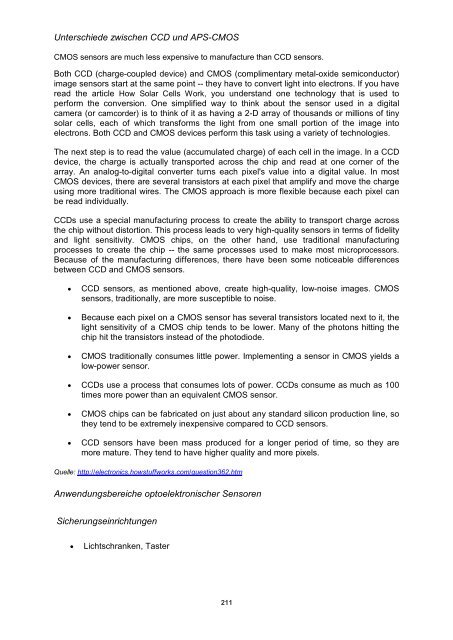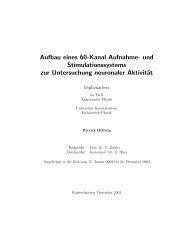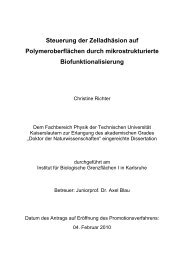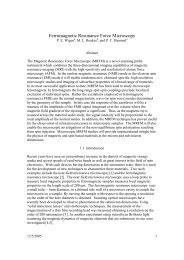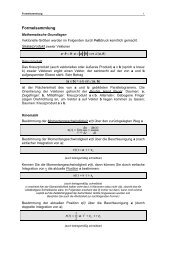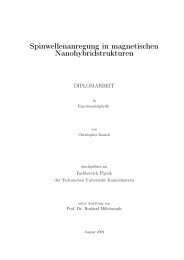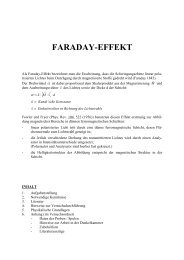Sensors and Actuators - Fachbereich Physik der Universität ...
Sensors and Actuators - Fachbereich Physik der Universität ...
Sensors and Actuators - Fachbereich Physik der Universität ...
Sie wollen auch ein ePaper? Erhöhen Sie die Reichweite Ihrer Titel.
YUMPU macht aus Druck-PDFs automatisch weboptimierte ePaper, die Google liebt.
Unterschiede zwischen CCD und APS-CMOS<br />
CMOS sensors are much less expensive to manufacture than CCD sensors.<br />
Both CCD (charge-coupled device) <strong>and</strong> CMOS (complimentary metal-oxide semiconductor)<br />
image sensors start at the same point -- they have to convert light into electrons. If you have<br />
read the article How Solar Cells Work, you un<strong>der</strong>st<strong>and</strong> one technology that is used to<br />
perform the conversion. One simplified way to think about the sensor used in a digital<br />
camera (or camcor<strong>der</strong>) is to think of it as having a 2-D array of thous<strong>and</strong>s or millions of tiny<br />
solar cells, each of which transforms the light from one small portion of the image into<br />
electrons. Both CCD <strong>and</strong> CMOS devices perform this task using a variety of technologies.<br />
The next step is to read the value (accumulated charge) of each cell in the image. In a CCD<br />
device, the charge is actually transported across the chip <strong>and</strong> read at one corner of the<br />
array. An analog-to-digital converter turns each pixel's value into a digital value. In most<br />
CMOS devices, there are several transistors at each pixel that amplify <strong>and</strong> move the charge<br />
using more traditional wires. The CMOS approach is more flexible because each pixel can<br />
be read individually.<br />
CCDs use a special manufacturing process to create the ability to transport charge across<br />
the chip without distortion. This process leads to very high-quality sensors in terms of fidelity<br />
<strong>and</strong> light sensitivity. CMOS chips, on the other h<strong>and</strong>, use traditional manufacturing<br />
processes to create the chip -- the same processes used to make most microprocessors.<br />
Because of the manufacturing differences, there have been some noticeable differences<br />
between CCD <strong>and</strong> CMOS sensors.<br />
• CCD sensors, as mentioned above, create high-quality, low-noise images. CMOS<br />
sensors, traditionally, are more susceptible to noise.<br />
• Because each pixel on a CMOS sensor has several transistors located next to it, the<br />
light sensitivity of a CMOS chip tends to be lower. Many of the photons hitting the<br />
chip hit the transistors instead of the photodiode.<br />
• CMOS traditionally consumes little power. Implementing a sensor in CMOS yields a<br />
low-power sensor.<br />
• CCDs use a process that consumes lots of power. CCDs consume as much as 100<br />
times more power than an equivalent CMOS sensor.<br />
• CMOS chips can be fabricated on just about any st<strong>and</strong>ard silicon production line, so<br />
they tend to be extremely inexpensive compared to CCD sensors.<br />
• CCD sensors have been mass produced for a longer period of time, so they are<br />
more mature. They tend to have higher quality <strong>and</strong> more pixels.<br />
Quelle: http://electronics.howstuffworks.com/question362.htm<br />
Anwendungsbereiche optoelektronischer Sensoren<br />
Sicherungseinrichtungen<br />
• Lichtschranken, Taster<br />
211


